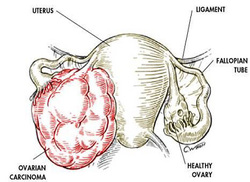Pathology definition - Ovarian Tumor ( Surface Epithelium Origin)

Ovarian Tumor ( Surface epithelium origin)
Ovarian tumor may derived from surface epithelium. 75% of ovarian tumor may derived from surface epthelium. There are few forms of ovarian tumor which derive from surface epithelium. These includes, clear cell tumor, mucinous cystadenocarcinoma, mucinous cystadenoma, serous cystadenoma, papillary serous cystadenocarcinoma, endometroid tumor and Brenner tumor. Ovarian carcinoma may present with elevated CA- 125.
Patient with ovarian tumor may complain with loss of weight, anorexia and abdominal/ pelvic pressure/ discomfort. Clear cell tumor is a rare malignant tumor which consists of sheets of clear cells. Mucinous cystadenocarcinoma may present with pseudomyxoma peritonei ( which is an intraperitoneal accumulation of the mucinous material). Mucinous cystadenocarcinoma is a mucus secreting atypical columnar epithelium malignant tumor. There will loss of glands architecture and further necrosis of the cells. Mucinous cystadenoma is a benign cyst with columnar cells filled with mucin. Mucinous cystadenoma is a multilocular tumor.
Serous cystadenoma is benign cyst which is bilateral in nature with fallopian tube like epithelium. Papillary serous cystadenocarcinoma is also bilateral malignant cyst with psammoma bodies which lined by stratified atypical epithelium. Papillary serous cystadenocarcinoma may shows papillary growth.
Endometroid tumor is a tumor which is malignant in nature and representing endometrium.
Brenner tumor is a benign tumor. Brenner tumor consists of nest of cell which is similar to bladder transitional epithelium with fibrous stroma.
The treatment may focus on surgical removal of the tumor with oophorectomy or hysterectomy performed and chemotherapy.
Ovarian tumor may derived from surface epithelium. 75% of ovarian tumor may derived from surface epthelium. There are few forms of ovarian tumor which derive from surface epithelium. These includes, clear cell tumor, mucinous cystadenocarcinoma, mucinous cystadenoma, serous cystadenoma, papillary serous cystadenocarcinoma, endometroid tumor and Brenner tumor. Ovarian carcinoma may present with elevated CA- 125.
Patient with ovarian tumor may complain with loss of weight, anorexia and abdominal/ pelvic pressure/ discomfort. Clear cell tumor is a rare malignant tumor which consists of sheets of clear cells. Mucinous cystadenocarcinoma may present with pseudomyxoma peritonei ( which is an intraperitoneal accumulation of the mucinous material). Mucinous cystadenocarcinoma is a mucus secreting atypical columnar epithelium malignant tumor. There will loss of glands architecture and further necrosis of the cells. Mucinous cystadenoma is a benign cyst with columnar cells filled with mucin. Mucinous cystadenoma is a multilocular tumor.
Serous cystadenoma is benign cyst which is bilateral in nature with fallopian tube like epithelium. Papillary serous cystadenocarcinoma is also bilateral malignant cyst with psammoma bodies which lined by stratified atypical epithelium. Papillary serous cystadenocarcinoma may shows papillary growth.
Endometroid tumor is a tumor which is malignant in nature and representing endometrium.
Brenner tumor is a benign tumor. Brenner tumor consists of nest of cell which is similar to bladder transitional epithelium with fibrous stroma.
The treatment may focus on surgical removal of the tumor with oophorectomy or hysterectomy performed and chemotherapy.
